Abstract
Objective:
To evaluate the effect of curcumin on olanzapine-induced obesity in rats.
Materials and Methods:
Sprague-Dawley (SD) rats were used for experiments. The animals were divided into six groups, namely, normal control, olanzapine control, betahistine (10 mg/kg), and curcumin 50, 100, and 200 mg/kg treated groups. Except the normal control group, all other animals were administered with olanzapine 4 mg/kg intraperitoneally to induce obesity. The drugs were administered once daily, per oral for 28 days. During the experiment, body weight changes and behavior alterations were monitored at regular intervals. At the end of the experiment, blood sample was collected from all the experimental animals for biochemical analysis. Part of the liver and kidney tissues was harvested from the sacrificed animals and preserved in neutral formalin for histopathological studies.
Results:
Curcumin showed a significant reduction in olanzapine-induced body weight gain on the rats and improved the locomotor effects. The effect of curcumin on olanzapine-induced body weight gain is not comparable with that of betahistine.
Conclusion:
This study has shown metabolic alteration effect of curcumin on olanzapine, an antipsychotic drug, treated SD rats.
SUMMARY
Olanzapine is an atypical antipsychotic drug used for the treatment of schizophrenia and bipolar disorder. Obesity is an adverse effect of olanzapine, and the present study was made an attempt to study the effect of curcumin on olanzapine-induced obesity in rats. In this present study, curcumin significantly reduced olanzapine-induced body weight gain in rats.
Abbreviations Used: 5HT: 5-hydroxytryptamine, ALP: Alkaline phosphatase, ALT: Alanine transaminase, ANOVA: Analysis of variance, AST: Aspartate transaminase, CMC: Carboxymethyl cellulose, D: Dopamine, H and E: Hematoxylin and Eosin stain, H: Histamine, HDL-C: Highdensity lipoprotein cholesterol, IP: Intraperitoneal, MAO: Monoamine oxidase, NaOH: Sodium hydroxide, SD rats: Sprague Dawley rats, TCs: Total cholesterols, TG: Triglyceride.
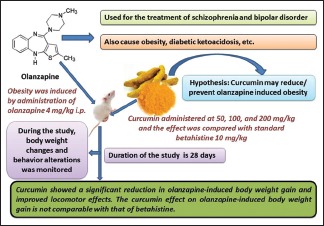
Key words: Betahistine, curcumin, obesity, olanzapine
INTRODUCTION
Antipsychotic drugs are very much essential in the management and treatment of various mental illnesses, such as schizophrenia and other psychoses. Although they have many beneficial effects, they are also not devoid of serious side effects.[1]
The adverse effects of these drugs could be general health risk to serious metabolic disorders such as obesity and diabetic ketoacidosis. The patients' noncompliance due to these side effects is already reported. One of the most marked untoward effects is the development of obesity. The extent of weight gain depends on the psychiatric drug used and its mechanism of action. Typical antipsychotics show relatively low weight gain, whereas the atypical drugs such as olanzapine exhibit high rate of weight gain in patients.[2] It is proved that the strong affinity of olanzapine to bind and block serotonin (5-hydroxytryptamine [HT]) and histamine (H) receptors (5-HT2C, 5-HT2A, and H1) is closely associated with the weight gain.[3]
Obesity is one of the serious health issues around the globe. It affects the routine lifestyle as well as the longevity of life. It is alarming that significant populations of many countries are obese, and the rate is increasing. Irrespective of the region and socioeconomic status, adult as well as childhood obesity is a major threat to human. In this scenario, development of obesity other than the normal metabolic disorders such as drug-induced obesity is of greater concern. Weight gain due to antipsychotic drugs attracts major attention as it is associated with hypertension, stroke, cardiovascular diseases, respiratory disorders, such as sleeping apnea, erectile dysfunction, and some kind of cancers. Weight gain due to olanzapine intake lead to patients' non-compliance and discontinuation of medication, which subsequently causes the relapse of mental illness.[4]
The management of weight gain induced by olanzapine has very limited options. Administration of betahistine, metformin, and fluoxetine is found to be effective to significant extents.[5,6] Inclusion of drugs which control the olanzapine-induced obesity is also a clinical concern due to the side effects of these agents and patients compliance. Natural compounds with low toxicity profiles may be well suited in search of an agent which can treat or manage the olanzapine-induced obesity. Compounds such as curcumin and myricetin are proved to be effective in controlling obesity and related conditions due to diet as well as metabolic disorders.[7,8]
Turmeric (Curcuma longa) belongs to the family of Zingiberaceae and is a spice used around the world. There were many compounds have been isolated from turmerics such as volatile oils and curcuminoids. Curcumin is a diferuloylmethane, the yellow pigment present in turmeric. The blood sugar lowering as well as anti-obesity activity of curcumin is well established by the animal as well as human studies. The preventive and curative effects of curcumin on obesity and obesity-related complications are exhibited through various mechanisms such as downregulation of tumor necrosis factor expression and suppression of nuclear factor-κB activation.[7] Curcumin is found to be beneficial in the prevention and treatment of various pro-inflammatory chronic diseases such as neurodegenerative, pulmonary, cardiovascular, autoimmune, metabolic, and neoplastic diseases. Apart from anti-inflammatory action, it also exhibits hypoglycemic, antibacterial, antiviral, anticoagulant, antioxidant, antitumor, and anticarcinogenic activities.[9] Curcumin inhibits both monoamine oxidase (MAO)-A and MAO-B receptors, producing antidepressant action.[10] Kumar et al. were studied the effect of curcumin on dopamine receptor expression rate in streptozotocin-induced diabetic rats and found that curcumin inhibits cerebellum dopamine D1 receptor expression downregulation in the diabetic rats,[11] which may help prevent antipsychotics-induced depression and pseudoparkinsonism.
The scientific information about the effectiveness of curcumin on body weight gain due to antipsychotics is very less even though it has a significant preventive effect. A few studies reported the activity of curcumin on olanzapine-induced weight gain. Ramesh et al. reported that the administration of curcumin (50 mg/kg) in combination with telmisartan (5 mg/kg) significantly inhibited the olanzapine-induced weight gain.[12] In search of a safe and effective agent to treat the olanzapine-induced weight gain, the present study was carried out to explore the anti-obesity action of curcumin on olanzapine-induced weight gain in Sprague-Dawley (SD) rats.
MATERIALS AND METHODS
Chemicals
Olanzapine and curcumin were purchased from Sigma-Aldrich, USA. Curcumin was suspended with 0.5% w/v of carboxymethyl cellulose (CMC). Olanzapine was dissolved in 0.1 N hydrochloric acid, and pH was adjusted to ~5.5 (using 0.1 N NaOH) and final volume was adjusted with distilled water.[13]
Animals
Healthy, adult, female SD rats weighing 160 ± 10 g were used for the present study. The experimental animals were obtained from the central animal house, AIMST University, Malaysia. The animals were housed in Wi-Fi free zone, large, spacious polyacrylic cages at an ambient room temperature with 12-h-light/12-h-dark cycle. The animals were fed with water, and normal rats pellet diet ad libitum. Prior approval was obtained from AIMST University Human and Animal Ethics Committee (AUHAEC2/FOP/SP/2015) to carry out the study, and the study was conducted according to the Animal Research Review Panel guidelines.
Effect of curcumin on olanzapine-induced obesity
In preliminary studies, both male and female rats were used for the study and no significant body weight gain was observed in male animals treated with olanzapine 4 mg/kg intraperitoneal (IP). Hence, the study was carried out with female animals. Healthy, adult female rats were divided into six groups of six animals each and treated as follows:
Group I: Normal control
Group II: Olanzapine control 4 mg/kg
Group III: Betahistine 10 mg/kg; olanzapine 4 mg/kg
Group IV: Curcumin 50 mg/kg; olanzapine 4 mg/kg
Group V: Curcumin 100 mg/kg; olanzapine 4 mg/kg
Group VI: Curcumin 200 mg/kg; olanzapine 4 mg/kg.
The animals in Group I were considered normal control and this group was treated with drug vehicle alone. Olanzapine was dissolved in 0.1 N hydrochloric acid, and betahistine/curcumin was suspended with 0.5% CMC. The Group II animals were treated with IP injection of olanzapine (4 mg/kg). The animals with Group III to VI were treated orally with betahistine 10 mg/kg, curcumin 50 mg/kg, curcumin 100 mg/kg, and curcumin 200 mg/kg, respectively, along with IP injection of olanzapine (4 mg/kg). All the drugs were administered once daily for 28 days. During the study, changes in body weight and behavioral alterations were monitored at regular intervals. On prestudy day and end of the study, rats were anesthetized with diethyl ether and 1 ml of blood was collected for biochemical analysis.
At the end of the study, the animals were sacrificed, and liver and kidney were harvested and weighted.
Body weight analysis
Weight of each animal in each group was recorded at weekly intervals. The percentage change in body weight was calculated and recorded.
Behavioral analysis
The locomotor activity, immobilization time, and grip strength were evaluated on prestudy day and end of the experiment using the method described by elsewhere.[14]
Locomotor activity
The rats' activity was recorded in an actophotometer equipped with acrylic cage and six built-in photo sensors and digital counters' beams on both X and Y horizontal axis. The individual rat activity was monitored at room temperature for 10 min.
Water maze test (immobilization time)
The water maze consists of a circular tank with 90 cm diameter and wall 20 cm above the water level with 25°C water. Immobilization time was analyzed on the prestudy day and 28th day of the experiment.
Rota-rod test
Rota-rod apparatus was used to measure the time in seconds taken for the rats to fall from the rotating rod.
Biochemical analysis
The blood was collected from all the animals through retro-orbital sinus puncture. The serum was separated by centrifugation at 3000 RPM for 20 min at 4°C and stored at −80°C until further biochemical analysis.
The serum sample was used for the estimation of the glucose, aspartate transaminase (AST), alanine transaminase (ALT), alkaline phosphatase (ALP), urea, creatinine levels, total cholesterols (TCs), triglyceride (TG), and high-density lipoprotein-cholesterol (HDL-C) using a biochemical analyzer (ReflotronPlus System, Hoffmann-La Roche, USA). The low-density lipoprotein (LDL), HDL ratio, very-LDL (VLDL), and atherogenic dyslipidemia (AD) were calculated mathematically using formula TC/1.19 + TG/1.9 – HDL- cholesterol /1.1 – 38, [HDL-cholesterol/TC–HDL-cholesterol] × 100 [%], LDL/5 and log (TG/HDL-cholesterol), respectively.[15,16]
Gross pathology
At the end of the study, animals were sacrificed by cervical dislocation, abdomen was opened, and gross pathology was observed. The liver and kidney (both) were removed and absolute weight was measured.
Histopathological analysis
Part of the liver and kidney samples from normal control, olanzapine control, betahistine, and curcumin 200 mg/kg treated groups was preserved in 10% neutral formalin for histopathological analysis. The liver and kidney samples were embedded in paraffin after being dehydrated in alcohol and subsequently cleared with xylene. Five-micrometer thickness of liver and kidney section was prepared from paraffin blocks and stained with hematoxylin and eosin and mounted in neutral DPX medium, and the sections were examined under a light microscope.
Statistical analysis
The mean ± standard error of the mean values was calculated for each group. Statistical differences between the groups were determined using repeated measure ANOVA, followed by Tukey's post hoc test. P < 0.05 is considered statistically significant.
RESULTS
The animals treated with olanzapine and olanzapine + curcumin 50 mg showed a significant increase in body weight when compared to that of control [Table 1]. The curcumin 100 and 200 mg/kg treated animals showed significant inhibition in olanzapine-induced weight gain [Figure 1]. At the end of the study, no significant changes in locomotor action and muscular grip strength were observed [Tables 2 and 3]. In behavioral analysis, olanzapine and olanzapine + curcumin treated animals showed a significant reduction in immobilization time at the end of the study [Table 4].
Table 1.
Effect of curcumin on olanzapine-induced body weight gain of Sprague-Dawley rats

Figure 1.
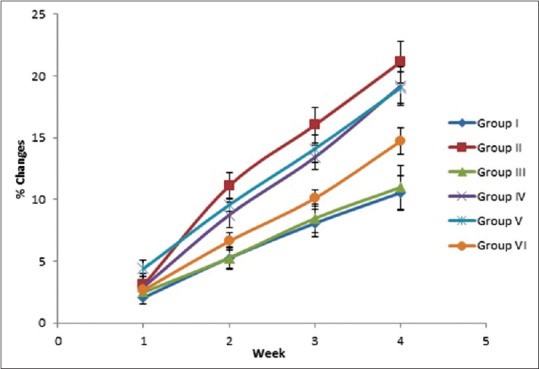
Percentage changes in body weight alterations of experimental animals. All the values are mean ± standard error of the mean (n = 6)
Table 2.
Effect of curcumin on locomotor activity of Sprague-Dawley rats
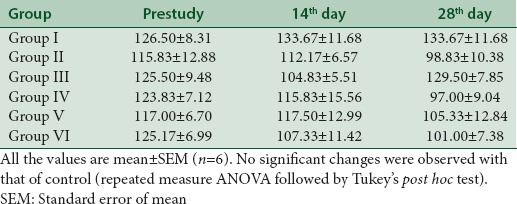
Table 3.
Effect of curcumin on grip strength (rota-rod) of Sprague-Dawley rats
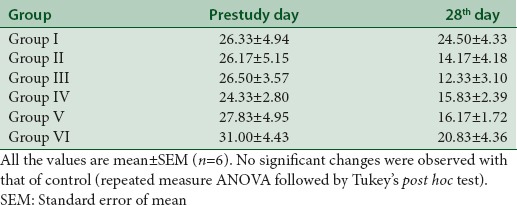
Table 4.
Effect of curcumin on immobilization time of Sprague-Dawley rats
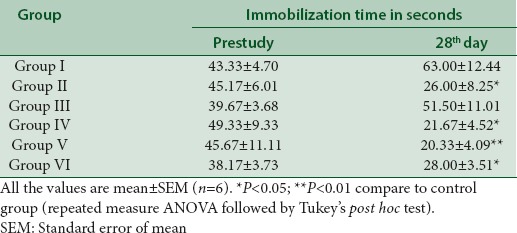
In biochemical analysis, no significant changes were observed in prestudy analysis. At the end of the study, olanzapine-control animals showed a significant increase in levels of AST, creatinine, TC, TG, LDL, VLDL, and AD levels compared with control group. The rat treated with olanzapine showed a significant increase (P < 0.05) in creatinine levels as compared to normal, whereas the animals treated with curcumin 200 mg/kg prevented the olanzapine effect on creatinine [Table 5].
Table 5.
Effects of curcumin on serum biochemical parameters of Sprague-Dawley rats

The animals treated with olanzapine and challenged with curcumin 50 and 100 mg/kg animals also showed significant increases in lipid profile, except HDL levels. Curcumin 200 mg/kg treated animals prevented the olanzapine's effect on lipid profile and also prevented the AD. The significantly increased level of VLDL was observed in olanzapine control and curcumin-treated groups. When compared to curcumin, betahistine showed significant lipid lowering effect and weight reduction effect in olanzapine-treated animals. Overall, betahistine and curcumin 200 mg/kg treated animals prevented olanzapine-induced hypertriglyceridemia and weight gain in rats [Table 6]. No significant changes in absolute and relative organ weight changes in liver and kidney were observed [Table 7]. In the histopathological analysis, olanzapine-control animals showed mild degeneration of hepatocytes in the liver and moderate to severe tubular cell degeneration in kidneys [Figure 2a and b]. Olanzapine + betahistine and olanzapine + curcumin 200 mg/kg treated animals showed mild degeneration of hepatocytes in the liver [Figure 2c and e]. Mild tubular cell degeneration in kidneys was seen in olanzapine + betahistine treated animals [Figure 2d].
Table 6.
Effects of curcumin on plasma lipid profile of Sprague-Dawley rats

Table 7.
Effect of curcumin on absolute and relative organ weight of Sprague-Dawley rats

Figure 2.
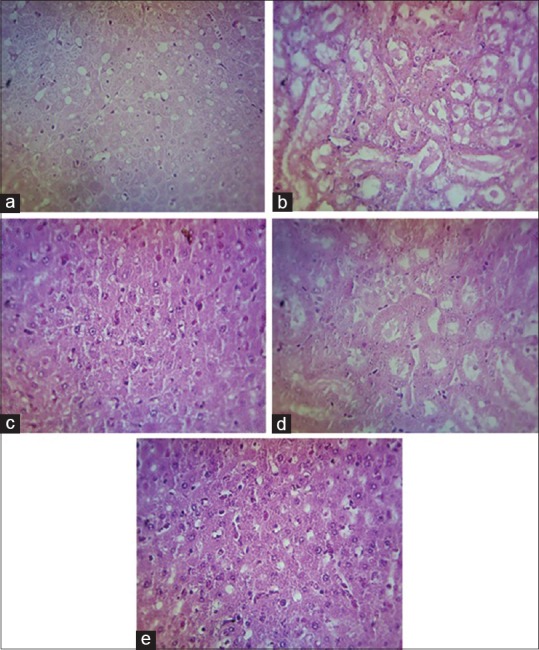
Histopathology of organs of olanzapine and curcumin treated animals. (a) Section from liver of olanzapine 4 mg/kg treated animals showing mild degeneration of hepatocytes and fatty changes (H and E, ×400), (b) section from kidney of olanzapine 4 mg/kg treated animals showing moderate to severe tubular cell degeneration (H and E, ×400), (c) section from liver of betahistine mg/kg treated animals showing mild degeneration of hepatocytes (H and E, ×400), (d) section from kidney of betahistine mg/kg treated animals showing mild tubular cell degeneration (H and E, ×400), and (e) section from liver of curcumin 200 mg/kg treated animals showing mild degeneration of hepatocytes (H and E, ×400)
DISCUSSION
Curcumin at 200 mg/kg and betahistine were significantly inhibited the olanzapine induced body weigh gain and hypertriglyceridemia. This suggests that curcumin inhibited the olanzapine induced body weigh gain at high dose levels, whereas curcumin 50 and 100 mg/kg failed to revise the olanzapine-induced metabolic effects. When comparing overall results, curcumin required a higher dose or prolonged duration to control the olanzapine-induced metabolic effects than betahistine.
In pilot studies, olanzapine did not increase the body weight of male animals; hence, female animals were used for the experiment. Albaugh et al. also reported the same.[17] In the main study, olanzapine and curcumin administered animals showed an uneven pattern of food intake and could not find any statistical variations in regular food and water intake. In many studies, olanzapine showed a significant increase in body weight, which is mainly attributable to an increase in body fats.[1]
Many authors are studied the effect of betahistine, Metformin, ranitidine, and melatonin against olanzapine-induced weight gain,[18,19] but the clinical efficacy is not established. Olanzapine-control animals exhibited decreased locomotor activity at the end of the study, but the values are not significant. This may be due to olanzapine-induced weight gain and increased adiposity.[20] van der Zwaal et al. also studied the effect of olanzapine on the locomotor action in male rats and concluded that olanzapine reduced the locomotor effect due to the alterations in the energy balance.[21]
At the end of the study, olanzapine-control animals showed increased levels of glucose, liver enzymes, and urinary markers, and this was supported by histopathological reports. Olanzapine is known to cause hyperglycemia and hypertriglyceridemia, and the same was reported in many studies.[22,23] Olanzapine-control rats showed an increase in their aminotransferase level compared to other groups. The pathogenesis of olanzapine-associated hepatotoxicity is still not well known and is mostly a transient phenomenon.[24] In the present study, nephrotoxicity was observed with olanzapine-control group which was not observed in curcumin-treated group. In other studies also, olanzapine-treated rats (0.5 and 2.5 mg/kg/day) showed nephrotoxicity and this may be due to oxidative stress.[25] Curcumin at higher doses/chronic administration may alter the metabolic effects of olanzapine. Curcumin is known to have anti-obesity, antidiabetic, anticancer, and antihyperlipidemic effects.[26,27] Curcumin also has neuroprotective effect, but the mechanism is not clear. It was hypothesized that neuroprotective effect of curcumin is due to its inhibition of Wnt/β-catenin signaling pathway and anti-inflammatory and antioxidant properties.[28,29] Weight gain due to inhibition of dopamine receptors by olanzapine is a well-known fact.[30,31] Kumar et al. studied the curcumin effect on dopamine (both D1 and D2) receptor expression rate and found that curcumin increases the expression of D1 and D2 dopamine receptor (upregulation) in cerebral cortex of diabetic rats.[11] Curcumin also revokes the depleted levels of serotonin and dopamine without affecting norepinephrine.[10] The open-label study of curcumin C-3 complex in schizophrenia also in progress to evaluate the beneficial effects in the treatment of schizophrenia (NCT01875822).[32] If curcumin shows any beneficial effects in the treatment of schizophrenia which may give a new therapeutic lead to avoid the using existing pharmaceutical substances or may give adjuvant treatment regimen to reduce the severity of adverse events caused using existing pharmaceutical substances.
In this study, we have evaluated the effect of curcumin on olanzapine-induced body weight gain and found that curcumin 200 mg/kg inhibits the olanzapine-induced body weight gain. This may be due to curcumin's antioxidant and dopaminergic effects.
CONCLUSION
Chronic administration of olanzapine has increased body weight and altered the metabolic pattern of the animals, whereas curcumin 200 mg/kg administration significantly inhibited the olanzapine-induced weight gain. The antioxidant and dopaminergic effects of curcumin have to be investigated further to confirm the mechanism.
Financial support and sponsorship
Nil.
Conflicts of interest
There are no conflicts of interest.
REFERENCES
- 1.Eder U, Mangweth B, Ebenbichler C, Weiss E, Hofer A, Hummer M, et al. Association of olanzapine-induced weight gain with an increase in body fat. Am J Psychiatry. 2001;158:1719–22. doi: 10.1176/appi.ajp.158.10.1719. [DOI] [PubMed] [Google Scholar]
- 2.Vanina Y, Podolskaya A, Sedky K, Shahab H, Siddiqui A, Munshi F, et al. Body weight changes associated with psychopharmacology. Psychiatr Serv. 2002;53:842–7. doi: 10.1176/appi.ps.53.7.842. [DOI] [PubMed] [Google Scholar]
- 3.Reynolds GP, Zhang ZJ, Zhang XB. Association of antipsychotic drug-induced weight gain with a 5-HT2C receptor gene polymorphism. Lancet. 2002;359:2086–7. doi: 10.1016/S0140-6736(02)08913-4. [DOI] [PubMed] [Google Scholar]
- 4.Allison DB, Mentore JL, Heo M, Chandler LP, Cappelleri JC, Infante MC, et al. Antipsychotic-induced weight gain: A comprehensive research synthesis. Am J Psychiatry. 1999;156:1686–96. doi: 10.1176/ajp.156.11.1686. [DOI] [PubMed] [Google Scholar]
- 5.Bustillo JR, Lauriello J, Parker K, Hammond R, Rowland L, Bogenschutz M, et al. Treatment of weight gain with fluoxetine in olanzapine-treated schizophrenic outpatients. Neuropsychopharmacology. 2003;28:527–9. doi: 10.1038/sj.npp.1300089. [DOI] [PubMed] [Google Scholar]
- 6.Baptista T, ElFakih Y, Uzcátegui E, Sandia I, Tálamo E, Araujo de Baptista E, et al. Pharmacological management of atypical antipsychotic-induced weight gain. CNS Drugs. 2008;22:477–95. doi: 10.2165/00023210-200822060-00003. [DOI] [PubMed] [Google Scholar]
- 7.Aggarwal BB. Targeting inflammation-induced obesity and metabolic diseases by curcumin and other nutraceuticals. Annu Rev Nutr. 2010;30:173–99. doi: 10.1146/annurev.nutr.012809.104755. [DOI] [PMC free article] [PubMed] [Google Scholar]
- 8.Liang T, Wang YY, Zhang C, Ling H, Zhao S, Fang X. Hypolipidemic effect of myricetin. Chin J Lab Diagn. 2009;13:1670–2. [Google Scholar]
- 9.Aggarwal BB, Harikumar KB. Potential therapeutic effects of curcumin, the anti-inflammatory agent, against neurodegenerative, cardiovascular, pulmonary, metabolic, autoimmune and neoplastic diseases. Int J Biochem Cell Biol. 2009;41:40–59. doi: 10.1016/j.biocel.2008.06.010. [DOI] [PMC free article] [PubMed] [Google Scholar]
- 10.Kulkarni S, Dhir A, Akula KK. Potentials of curcumin as an antidepressant. ScientificWorldJournal. 2009;9:1233–41. doi: 10.1100/tsw.2009.137. [DOI] [PMC free article] [PubMed] [Google Scholar]
- 11.Kumar TP, Antony S, Gireesh G, George N, Paulose CS. Curcumin modulates dopaminergic receptor, CREB and phospholipase C gene expression in the cerebral cortex and cerebellum of streptozotocin induced diabetic rats. J Biomed Sci. 2010;17:43. doi: 10.1186/1423-0127-17-43. [DOI] [PMC free article] [PubMed] [Google Scholar]
- 12.Ramesh PR, Parasuraman S, Mohammad S, Devika G. Effects of curcumin and telmisartan on olanzapine and high fructose diet-induced metabolic syndrome in Spraugue-Dawley rats. Pharmacogn J. 2012;4:25–9. [Google Scholar]
- 13.Cooper GD, Pickavance LC, Wilding JP, Halford JC, Goudie AJ. A parametric analysis of olanzapine-induced weight gain in female rats. Psychopharmacology (Berl) 2005;181:80–9. doi: 10.1007/s00213-005-2224-4. [DOI] [PubMed] [Google Scholar]
- 14.Parasuraman S, Sujithra J, Syamittra B, Yeng WY, Ping WY, Muralidharan S, et al. Evaluation of sub-chronic toxic effects of petroleum ether, a laboratory solvent in Sprague-Dawley rats. J Basic Clin Pharm. 2014;5:89–97. doi: 10.4103/0976-0105.141943. [DOI] [PMC free article] [PubMed] [Google Scholar]
- 15.Hermans MP, Ahn SA, Rousseau MF. log (TG)/HDL-C is related to both residual cardiometabolic risk and ß-cell function loss in type 2 diabetes males. Cardiovasc Diabetol. 2010;9:88. doi: 10.1186/1475-2840-9-88. [DOI] [PMC free article] [PubMed] [Google Scholar]
- 16.Petchi RR, Parasuraman S, Vijaya C. Antidiabetic and antihyperlipidemic effects of an ethanolic extract of the whole plant of Tridax procumbens (Linn.) in streptozotocin-induced diabetic rats. J Basic Clin Pharm. 2013;4:88–92. doi: 10.4103/0976-0105.121655. [DOI] [PMC free article] [PubMed] [Google Scholar]
- 17.Albaugh VL, Henry CR, Bello NT, Hajnal A, Lynch SL, Halle B, et al. Hormonal and metabolic effects of olanzapine and clozapine related to body weight in rodents. Obesity (Silver Spring) 2006;14:36–51. doi: 10.1038/oby.2006.6. [DOI] [PMC free article] [PubMed] [Google Scholar]
- 18.Lian J, Huang XF, Pai N, Deng C. Preventing olanzapine-induced weight gain using betahistine: A study in a rat model with chronic olanzapine treatment. PLoS One. 2014;9:e104160. doi: 10.1371/journal.pone.0104160. [DOI] [PMC free article] [PubMed] [Google Scholar]
- 19.Ranjbar F, Ghanepour A, Sadeghi-Bazargani H, Asadlo M, Alizadeh A. The effect of ranitidine on olanzapine-induced weight gain. Biomed Res Int. 2013;2013:639391. doi: 10.1155/2013/639391. [DOI] [PMC free article] [PubMed] [Google Scholar]
- 20.Raskind MA, Burke BL, Crites NJ, Tapp AM, Rasmussen DD. Olanzapine-induced weight gain and increased visceral adiposity is blocked by melatonin replacement therapy in rats. Neuropsychopharmacology. 2007;32:284–8. doi: 10.1038/sj.npp.1301093. [DOI] [PubMed] [Google Scholar]
- 21.van der Zwaal EM, Luijendijk MC, Evers SS, la Fleur SE, Adan RA. Olanzapine affects locomotor activity and meal size in male rats. Pharmacol Biochem Behav. 2010;97:130–7. doi: 10.1016/j.pbb.2010.05.009. [DOI] [PubMed] [Google Scholar]
- 22.Marwick KF, Taylor M, Walker SW. Antipsychotics and abnormal liver function tests: Systematic review. Clin Neuropharmacol. 2012;35:244–53. doi: 10.1097/WNF.0b013e31826818b6. [DOI] [PubMed] [Google Scholar]
- 23.Lui SY, Tso S, Lam M, Cheung EF. Possible olanzapine-induced hepatotoxicity in a young Chinese patient. Hong Kong Med J. 2009;15:394–6. [PubMed] [Google Scholar]
- 24.Ozcanli T, Erdogan A, Ozdemir S, Onen B, Ozmen M, Doksat K, et al. Severe liver enzyme elevations after three years of olanzapine treatment: A case report and review of olanzapine associated hepatotoxicity. Prog Neuropsychopharmacol Biol Psychiatry. 2006;30:1163–6. doi: 10.1016/j.pnpbp.2006.03.014. [DOI] [PubMed] [Google Scholar]
- 25.Shah R, Subhan F, Ali G, Ullah I, Ullah S, Shahid M, et al. Olanzapine induced biochemical and histopathological changes after its chronic administration in rats. Saudi Pharm J. 2016;24:698–704. doi: 10.1016/j.jsps.2015.06.006. [DOI] [PMC free article] [PubMed] [Google Scholar]
- 26.Jang EM, Choi MS, Jung UJ, Kim MJ, Kim HJ, Jeon SM, et al. Beneficial effects of curcumin on hyperlipidemia and insulin resistance in high-fat-fed hamsters. Metabolism. 2008;57:1576–83. doi: 10.1016/j.metabol.2008.06.014. [DOI] [PubMed] [Google Scholar]
- 27.Abouzeid AH, Patel NR, Rachman IM, Senn S, Torchilin VP. Anti-cancer activity of anti-GLUT1 antibody-targeted polymeric micelles co-loaded with curcumin and doxorubicin. J Drug Target. 2013;21:994–1000. doi: 10.3109/1061186X.2013.840639. [DOI] [PubMed] [Google Scholar]
- 28.Kulkarni SK, Dhir A. An overview of curcumin in neurological disorders. Indian J Pharm Sci. 2010;72:149–54. doi: 10.4103/0250-474X.65012. [DOI] [PMC free article] [PubMed] [Google Scholar]
- 29.Tiwari SK, Agarwal S, Tripathi A, Chaturvedi RK. Bisphenol-A mediated inhibition of hippocampal neurogenesis attenuated by curcumin via canonical Wnt pathway. Mol Neurobiol. 2016;53:3010–29. doi: 10.1007/s12035-015-9197-z. [DOI] [PubMed] [Google Scholar]
- 30.Reynolds GP. Receptor mechanisms of antipsychotic drug action in bipolar disorder-focus on asenapine. Ther Adv Psychopharmacol. 2011;1:197–204. doi: 10.1177/2045125311430112. [DOI] [PMC free article] [PubMed] [Google Scholar]
- 31.Reinholz J, Skopp O, Breitenstein C, Bohr I, Winterhoff H, Knecht S. Compensatory weight gain due to dopaminergic hypofunction: New evidence and own incidental observations. Nutr Metab (Lond) 2008;5:35. doi: 10.1186/1743-7075-5-35. [DOI] [PMC free article] [PubMed] [Google Scholar]
- 32.Open-Label Study of Curcumin C-3 Complex in Schizophrenia. [Last accessed on 2016 Apr 23]. Available from: https://www.clinicaltrials.gov/ct2/show/study/NCT01875822?view=record .


